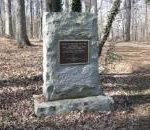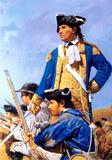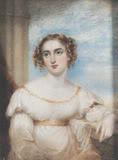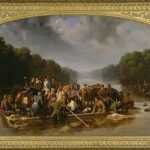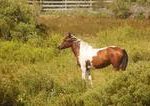Patriot and Heroine of the Revolutionary War
Historic Brattonsville Revolutionary War
historic site that includes the log cabin
home of Martha and William Bratton
in South Carolina
Martha Robertson was born about 1750 in Rowan County, North Carolina. Not much is known about her early life, but her acts of heroism during the Revolutionary War are very well known.
Martha Robertson married William Bratton, a Pennsylvanian of Irish parentage, who lived in the York District of South Carolina, just below the North Carolina border. In the troubled times that preceded the American Revolution, the Brattons’ courage and deportment gave them great influence among their neighbors and friends.
The year 1780 was a dark period for the patriots of South Carolina, the year the British invaded their state. The city of Charleston surrendered on May 12, and General Benjamin Lincoln and the his army became prisoners of war. After this initial success, the British secured the important post of Ninety-Six; another contingent scoured the countryside bordering on the Savannah; and Lord Cornwallis passed the Santee and took the town of Georgetown.
Armed garrisons were posted throughout the state, which lay at the mercy of the enemy. Sir Henry Clinton boasted that here at least, the American Revolution was ended. A proclamation was issued, denouncing those who would fight them, and offering pardon to those who would acknowledge them and accept British protection. Many of the people, believing resistance was hopeless, took the offered protection, while those who refused absolute submission were exiled or imprisoned.
But the colonists of York District of South Carolina never gave their paroles, nor accepted protection as British subjects; preferring resistance to subjection. A few individuals sought refuge in North Carolina. They were followed by the Whigs of Chester and other districts bordering on that state, who fled from the British troops as they marched into the upper country.
Those patriot exiles soon organized themselves in companies, and under their gallant leaders, General Thomas Sumter, Colonel William Bratton and others, began to collect on the frontier, and to harass the enemy by sudden unexpected attacks. At the time, the state was unable to feed, clothe or arm the soldiers. They had to depend on themselves. They gathered in the woods and swamps, and frequently wanted both for food and clothing.
During his long absences from home, serving with the patriot resistance, Colonel Bratton was seldom able to see or communicate with his family, and Martha must have been constantly anxious for his safety. She, however, never complained, but devoted herself to the care of her family, striving at the same time to aid and encourage her neighbors.
The Battle of Huck’s Defeat
British officers and troops were sent in marauding parties to every corner of South Carolina, authorized to punish every Patriot, and to call upon the local Tories (colonists who supported the British) to help them. A body of these marauders were attacked and defeated in June 1780 by colonials under the command of Colonel Bratton, Major Wynn, and Captain McClure.
The report of this incident reached a strong detachment of British nearby, and they sent Captain Christian Huck and four hundred cavalrymen and a considerable body of Tories to avenge the deaths of their countrymen.
In July 1780, Martha Bratton was on the front porch of her log cabin home with her small son when a force of Tories and British regulars rode up one evening. Captain Huck demanded to know where her husband was. He was off with the American army of General Thomas Sumter, she replied, but did not know his exact location.
Captain Huck threatened that if she did not induce her husband to come in and join the Tories, he would be caught and executed. Martha reaponded, “I would rather see him remain true to his duty to his country, even if he perishes in Sumter’s army.” She would say nothing to betray her husband.
One of Huck’s soldiers, infuriated at her boldness, vowed to make her talk. He grabbed a reaping hook that hung on the wall and held it to her throat, threatening to decapitate her unless she told what she knew. Martha responded: “I told the simple truth and could not tell if I would; but now I add that I would not if I could.”
The bully was poised to carry out his threat when he was struck senseless by the hilt of the sword of Captain John Adamson, one of his superiors, who followed up by battering him with the flat of his blade and kicking him into the yard. Adamson turned and apologized to Mrs. Bratton.
Huck then ordered Martha to prepare supper for him and his troopers. We can only imagine her feelings as saw her house occupied by the enemies of her husband and her country, but to protect her family, she felt compelled to do as they asked. Having prepared the meal, she went with her children to an upstairs room.
Such mistreatment of women was not uncommon during what was essentially a guerilla war.
After they had eaten, Huck and his officers went to a neighbor’s house about half a mile away, and encamped around it for the night. Sentinels were posted along the road that passed the house.
Colonel Bratton and a group of his neighbors and friends had that day left Mecklenburg County, North Carolina, under the conviction that the Tories would shortly send forces to their homes, to avenge their defeat at the recent battle.
With a force of only 75 men, Colonel Bratton and Captain McClure, having received information about the enemy and their location, arrived at the British encampment early the next morning. After they concealed their horses in a swamp, Bratton inspected the camp.
The party of Americans divided to enclose the enemy; one-half coming up the lane, the other sent around in the opposite direction. Huck and his officers were still sleeping when the attack began, and they were aroused by the sound of gunfire. Huck tried several times to rally his men, but they were scattered and confused. Some ran.
As the Americans pursued the British, the battle spread towards the Bratton house, and Martha and her children, anxious to look out, were in some danger. She forced her small son to sit inside the chimney where he would be safe from stray bullets.
The battle lasted about an hour; it was bloody but brief. The Patriots were victorious and many of the British soldiers were killed or mortally wounded; the rest escaped or were made prisoners.
About daylight, when the firing had ceased, Martha ventured out, fearful of finding her dearest relatives among the dead and wounded lying around her dwelling. But none of her loved ones had fallen.
Captain Christian Huck was killed in battle, and the officer second in command – Tory Captain John Adamson – was among the wounded. He pleaded to see Martha Bratton, and she instantly recognized him as the officer who had interfered on her behalf and saved her life the previous day. Martha opened her house to the wounded on both sides, and nursed Captain Adamson back to health.
Huck’s defeat encouraged men in the area to join the armed struggle against the British and was a turning point for the war in South Carolina. Within a few weeks a large contingent of volunteers had joined Sumter’s army in the attack on the British at Rocky Mount (August 1, 1780).
On August 6, 1780, at the Battle of Hanging Rock, South Carolina, lack of ammunition made it impossible for General Thomas Sumter and his troops to completely knock out the British. The battle raged for three hours without pause, causing many men to faint from the heat.
At the end, the British had lost 192 soldiers; the Americans lost 12 killed and 41 wounded. It should have been a total American victory but the American militia was untrained and suffered from extreme thirst.
The Gunpowder Incident
Before the fall of Charleston, when resistance throughout the state was virtually impossible because of a lack of ammunition, the governor of South Carolina had sent a supply of gunpowder to all the patriot regiments, to enable them to harass the invading army.
Most of the powder was stashed by the Patriots in the back country, in hollow trees and like hiding places; others fell into the hands of the enemy or were destroyed. A supply was given to Colonel Bratton, and in his absence Martha was left in charge of the gunpowder hidden on their property. The Tories informed the British officer in command of the nearest station of her stash, and a detachment was sent to seize the ammunition.
Martha was told that they were coming but did not have enough time to move the gunpowder. She was well aware that there was no way she could save the powder, but she could prevent the enemy from having it. She poured a trail of gunpowder far away from the building where it was stored to the spot where she stood, and when the soldiers came in view, set fire to it, and blew it up.
The explosion informed the British of what she had done. The officer in command demanded to know who had dared to do such a thing, and threatened revenge on the culprit. Reportedly, Martha Bratton answered, “It was I who did it. Let the consequence be what it will; I glory in having prevented the mischief contemplated by the cruel enemies of my country.”
When peace returned, William and Martha resumed the cultivation of their farm. Grateful for the preservation of their lives and property, they continued their agricultural pursuits to a ripe old age.
Colonel William Bratton died at his residence two miles south of Yorkville, Martha surviving him less than a year.
Martha Bratton died on January 9, 1816. They were buried beside each other.
Brattonsville, South Carolina, was named after the patriotic family. After the Brattons’ deaths, their son took over the family home. In 1839, he added a wing, which was used as a school for girls – Brattonsville Female Seminary. The Bratton house and homestead are listed in the National Register of Historic Places.
The Battle of Huck’s Defeat, though a minor engagement, helped convince the Patriots that armed resistance against the occupying British was possible. It is commemorated every year at Historic Brattonsville, which exists today as a 775-acre historical site, and is one of the most important and heavily visited cultural attractions in South Carolina.
SOURCES
Virtual American Biographies
National Women’s History Museum
The Women of the American Revolution
An American Revolution Heroine: Martha Bratton’s Defiance

